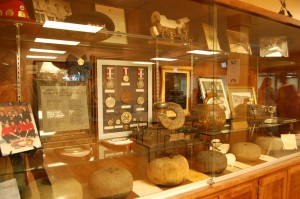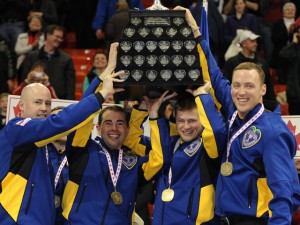Around the House: The Trophy Case
In 2009, the Fergus Curling Club celebrated its 175th anniversary of continuous curling, a remarkable accomplishment when you consider that in 1834, the town of Fergus, Ontario, consisted of a few farms, a church and a tavern. But the settlers were all Scots, and what better way to spend that first, cold winter than to heave blocks of wood down the frozen road in front of the tavern and take breaks between ends for a warming dram?
I had the pleasant job of producing a commemorative illustrated history of the Fergus Curling Club, and one of the highlights of my research was poring over old documents and photographs of curlers and curling events from the club’s past.
Just inside the club’s party room is a large wooden cabinet with glass doors. In this cabinet, prominently and proudly displayed, are mementos, photographs, trophies and relics that celebrate the history of curling in Fergus. It’s an impressive sight, and I spent more time than I thought I would standing in front of the glass, soaking in not only the tangible reminders of the club’s history, but also the ghostly presence of those first, intrepid curlers who brought the game across the ocean to their new land. In Fergus, those ghosts are present in the old granite stones and blocks of wood, the same rocks used by the town’s first curlers. Right there for everyone to see. History.
Trophies themselves signify accomplishment, effort and, ultimately, success. Ask anyone who has played for the honour of hoisting not just a prize from the bonspiel prize table, but an actual piece of hardware with your team’s name inscribed on it: it’s different. Trophies have their own stories. Having a gold medal placed around your neck may be pretty darn sweet, but think of our elite curlers as they are presented with the Brier or Scotties trophies. Notice how hands reach out as all members of the team itch to get hold of that hard-won, long-desired, perhaps once-in-a-lifetime statement of achievement. Hoisting it over their heads awkwardly, but hanging on hard. Trophies are special.
My first trophy (and I remember it well because I haven’t won too many since) came from the Stanley Gauthier competition at Montreal West Curling Club. The Stanley Gauthier is an event run by the Ladies Curling Association of the Royal Caledonia Curling Club Branch in Quebec and Eastern Ontario, a region where ties are very strong to the oldest curling traditions brought from Scotland. My teammates and I qualified because we had been curling for fewer than five years, and in my case, only one year. We battled strange ice, more experienced opponents and a distinct lack of confidence – but we overcame it all to emerge as winners.
We brought the precious trophy back to our club and placed it with others on the ledge perched above the glass overlooking our two sheets of ice. Congratulations were offered by our club mates, and we even had our picture in the local newspaper. The big time!
But the best accolade of all came from one of the veteran club members, an old-timer who had won his share of trophies over the course of a long career.
“Congratulations!” he said in a hand-written note to the team. “You’re real curlers now.”
I may see myself chiefly as a recreational club curler, but it’s kind of fun to think that somewhere out there, in a display case at a club in Eastern Ontario or Quebec, is a trophy with my name on it.
Every trophy tells a story, and when you put them all together in a display case – like the one I so admire in Fergus – you have more than that: you have a history. Next time you walk by your trophy case on the way to the ice or the dressing room or the bar, take a moment to read some of those names and acknowledge the history – and the ghosts – of your curling club.






